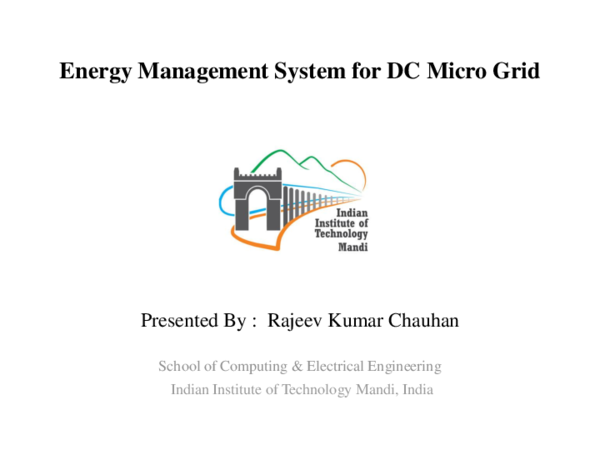Academia.edu no longer supports Internet Explorer.
To browse Academia.edu and the wider internet faster and more securely, please take a few seconds to upgrade your browser.
Energy Management System for DC Microgrid
Energy Management System for DC Microgrid
Related Papers
— As the number of DC loads are growing in our daily uses, the low voltage DC (LVDC) distribution system is becoming important. Power supplied through the low voltage AC (LVAC) distribution system needs both the AC/DC rectifier and the DC/DC converter to supply the DC loads. In comparison, LVDC system would only need the DC/DC converter to supply the DC loads. Integration of renewable energy sources at LV level, like rooftop photovoltaic (PV), fuel cells, etc. would be relatively easier with the LVDC system than the LVAC. So, the LVDC can be the viable solution to reduce multiple conversion losses in the system. This paper presents comparison between the existing LVAC with the prospective LVDC distribution system in terms of converter conversion efficiency. Constant AC and DC loads, generally used in household applications, are simulated using PSCAD/EMTDC for both the LVAC and the LVDC distribution system. The analysis of the effectiveness of LVDC system over LVAC distribution system has been presented.
Environmentally friendly technologies such as photovoltaics and fuel cells are DC sources. In the current power infrastructure, this necessitates converting the power supplied by these devices into AC for transmission and distribution which adds losses and complexity. The amount of DC loads in our buildings is ever-increasing with computers , monitors, and other electronics entering our workplaces and homes. This forces another conversion of the AC power to DC, adding further losses and complexity.In this study, an equivalent AC and DC distribution system are compared in terms of efficiency. 1. Advantages and Disadvantages of DC power transmission and distribution over the conventional AC power system Advantages of DC Transmission; • There are no Inductance and Surges (High Voltage waves for very short time) in DC transmission. • There is no concept of Skin effect in DC transmission. Therefore, small cross sectional area conductor required. • There are two conductors used in DC transmission while three conductors required in AC transmission. • Due to absence of inductance, there are very low voltage drop in DC transmission lines comparing with AC (if both Load and sending end voltage is same) • There is no concept of Skin effect in DC transmission. Therefore, small cross sectional area conductor required.
The paper devoted to the developing of DG system on the base of hybrid AC/DC network. The attention paid to microgrids with hybrid power sources (wind, PV-solar, fuel cell, bio gas and so on) with ability to deliver electrical energy on twin power buses for further supplying of customers with AC and DC power. As an example micro grid with dc and ac power sources supplying parking area was investigated.
2021 •
Various statistics indicate that many parts of India, especially rural and island regions, have either limited or no access to electricity. It is very expensive and difficult of installation of transmission line in these areas because of their geographical location. This problem leads to the uses of renewable energy sources to supply power to these remote areas. Most of these renewable energy source produce electricity in the form of DC. In today scenario most of people use invertor in house to store electricity in a battery which will reused during cut off hour. While electricity generation of renewable source is in the form of DC and transmission of this supply is in the form of AC. And a wide variety of daily utility devices such as cell phone chargers, laptops, laptop chargers, electric vehicle etc. operate on DC electricity. So to supply power from generation unit to the consumer multiple time of conversion from AC to DC and vice versa take place. Because of this conversion los...
The world has witnessed a rapid transformation in the field of electrical generation, transmission and distribution. We have been constantly developing and upgrading our technology to make the system more economically efficient. Currently, the industry faces an acute shortage of energy resources due to overconsumption by industries worldwide. This has compelled experts to look for alternatives to fossil fuels and other conventional sources of energy to produce energy in a more sustainable manner. The microgrid concept has gained popularity over the years and has become a common sight all over the world because of the ability of a microgrid to provide power to a localized section without being dependent on conventional resources. This paper focuses on development of such an AC hybrid microgrid, which receives power from distributed energy resources (DERs) such as a PV array alongside a battery storage system, and also uses an emergency diesel generator system and an online uninterrup...
IEEE Transactions on Smart Grid
Guest Editorial: Special Section on Smart DC Distribution Systems2014 •
RELATED PAPERS
2009 •
Darülmülk Konya Dergisi, 2022/1.
Konya’nın İlk ve Son Rehberi | Bekir Şahin2022 •
American Heart Journal
Mitral stenosis: Mitral dome excursion at M1 and the mitral opening snap—The concept of reciprocal heart sounds1988 •
Journal of Physics: Conference Series
On the reliability of 3D gel dosimetry2013 •
Southern Medical Journal
Transition Medicine: A Review of Current Theory and Practice2010 •
American Mineralogist
Iron pairs in beryl: New insights from electron paramagnetic resonance, synchrotron X-ray absorption spectroscopy, and ab initio calculations2013 •
Natural Products and Bioprospecting
Comparative Study on “Long-Dan”, “Qin-Jiao” and Their Adulterants by HPLC Analysis2014 •
Czech Journal of Food Sciences
Tyramine Production by Enterococci from Various Foodstuffs: A Threat to the Consumers2009 •

 Dr. Rajeev Kumar Chauhan
Dr. Rajeev Kumar Chauhan